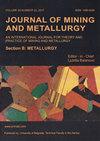超细铁精矿绿球团干燥特性研究
IF 1
4区 材料科学
Q3 METALLURGY & METALLURGICAL ENGINEERING
Journal of Mining and Metallurgy Section B-Metallurgy
Pub Date : 2023-01-01
DOI:10.2298/jmmb220810018w
引用次数: 0
摘要
超细铁精矿面临的挑战,如球团形成性能差,低爆破温度,和复杂的干燥热制度。为考察超细铁精矿绿球团的干燥特性,采用Weibull分布函数和Dincer模型对其干燥曲线进行拟合和分析。研究了干燥温度和风速对干燥球团强度的影响。研究结果表明,超细铁精矿绿球团的干燥过程分为升速、恒速和降速三个阶段。随着干燥温度和风速的升高,干燥时间缩短。拟合Weibull分布函数模型的决定系数R2范围为0.995 ~ 0.998,Dincer模型的决定系数R2范围为0.990 ~ 0.996。两种拟合模型与实验数据一致,证明是有效的。根据Dincer模型得到的Bi值,提高干燥系统初始阶段的干燥风速和后续阶段的干燥温度,可以有效地去除水分,降低绿球团破裂风险,保持生产效率。水分扩散系数和对流传质系数随温度和风速的升高而增大,由Weibull分布函数、Dincer模型和Fick第二定律决定,其大小为Deff > Dcal > D*eff。此外,由阿伦尼乌斯公式导出的超细铁精矿干燥活化能为4515.60 J/(mol?K)。值得注意的是,随着干燥温度的升高,干燥颗粒的强度增加,因为它们的内部结构更加致密。该研究为生料超细铁精矿球团的干燥模拟提供了理论支持,为选择不同的干燥条件和设计干燥设备提供了指导。本文章由计算机程序翻译,如有差异,请以英文原文为准。
Study on the drying characteristics of green pellets of ultrafine iron ore concentrate
Ultrafine iron ore concentrate pose challenges like poor pellets formation performance, low-bursting temperature, and a complex drying thermal regime. To examine the drying characteristics of green pellets of ultrafine iron ore concentrate, we employed Weibull distribution function and Dincer model to fit and analyze the corresponding drying curve. The effects of drying temperature and air speed on the strength of dried pellets were also studied. Our findings reveal that the drying process of green pellets of ultrafine iron ore concentrate involves three stages: ascending speed, constant speed, and descending speed. As the drying temperature and air speed increase, the drying time decreases. The coefficient of determination R2 for the fitted Weibull distribution function model ranged from 0.995 to 0.998, while the R2 value for the Dincer model ranged from 0.990 to 0.996. Both fitted models align with experimental data and prove to be effective. According to the Bi values obtained through the Dincer model, raising the drying air speed in the initial stage and the drying air temperature in the subsequent stage of the drying system can efficiently remove moisture, reduce green pellets rupture risk, and maintain productivity. The moisture diffusion coefficient and convective mass transfer coefficient increase with rising temperature and air velocity, following the order of Deff > Dcal > D*eff as determined by the Weibull distribution function, Dincer model, and Fick's second law. Additionally, the activation energy value of ultrafine iron ore concentrate for drying derived from the Arrhenius formula is 4515.60 J/(mol?K). Notably, increasing drying temperature increases the strength of dried particles due to their more compact and dense internal structure. This study offers theoretical support for simulating the drying of green ultrafine iron ore concentrate pellets and provides guidelines for selecting diverse drying conditions and designing drying equipment.
求助全文
通过发布文献求助,成功后即可免费获取论文全文。
去求助
来源期刊
CiteScore
2.00
自引率
40.00%
发文量
19
审稿时长
2 months
期刊介绍:
University of Belgrade, Technical Faculty in Bor, has been publishing the journal called Journal of Mining and Metallurgy since 1965 and in 1997 it was divided in two independent journals dealing with mining and metallurgy separately. Since 2009 Journal of Mining and Metallurgy, Section B: Metallurgy has been accepted in Science Citation Index Expanded.
Journal of Mining and Metallurgy, Section B: Metallurgy presents an international medium for the publication of contributions on original research which reflect the new progresses in theory and practice of metallurgy. The Journal covers the latest research in all aspects of metallurgy including hydrometallurgy, pyrometallurgy, electrometallurgy, transport phenomena, process control, solidification, mechanical working, solid state reactions, materials processing, surface treatment and relationships among processing, structure, and properties of materials.

 求助内容:
求助内容: 应助结果提醒方式:
应助结果提醒方式:


